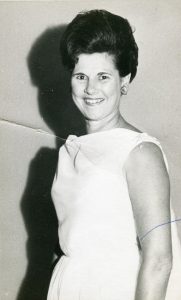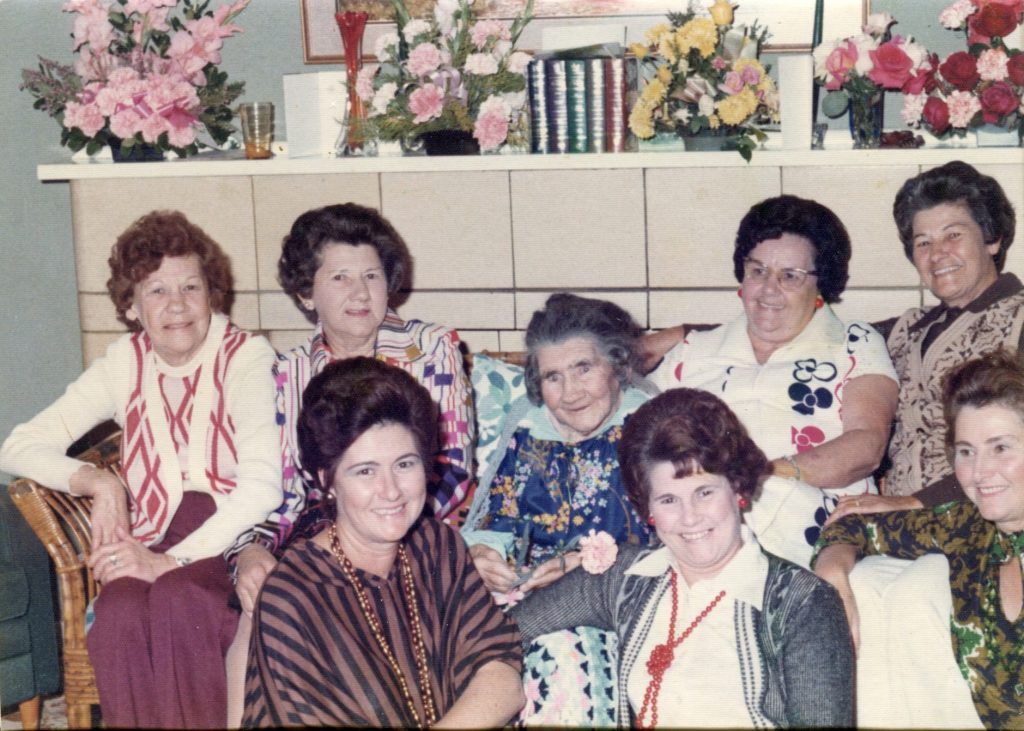by Heather Smith

Kathleen Marie McCarthy, born on the 2nd August 1923, was the seventh of nine children born to Cecily Anne (Miller) and her husband Herbert Eugene McCarthy. The family comprised seven girls and two boys.
Cecily was born in St. Marys and Eugene at Bega. Times were tough, so like many hundreds of men before him Eugene travelled to Riverstone to obtain employment with the Riverstone Meat Co. It was here that he met and married Cecily. Their children were born in the family’s tiny two bedroom cottage in Hunter Street, Riverstone. All except the youngest, Patricia, who was delivered by the midwife Sister Barnes in her maternity hospital in Garfield Road.
Life was very different in the early 1900s. There was no town water or electricity, no government assistance for widows or child endowment, and wages were low. Many families were very poor and life was harsh. Tragedy struck the family when at the age of 48 their father Eugene died from tuberculosis.
Cecily was left on her own to rear the five youngest children by taking in washing and ironing. The children all attended Riverstone Public school and Kate (Kathleen) went on to attend high school at Parramatta. She left school at 15 years and obtained work at the meat works in the boning room and preserver. When Australia entered the Second World War like all available workers she went to work in the munitions factory at St. Marys making incendiary bombs. Once peace was declared Kate soon obtained work in Sydney in the large department store Marcus Clark & Co.
The McCarthy girls Gwen, Joan, Thora, Eileen, Helen, Kate and Patsy had all matured into very glamorous and attractive young women much sort after by all the young men in the district at the local dances. Each Saturday night they danced either in the Masonic hall Riverstone, to the music of Dick Stacy’s band with Dick on the piano, Tommy Greenhalgh on drums and Billy Miller on the saxophone or they were off to the many dances held around the district. This was all done under the watchful eye of their mother who chaperoned her girls and refused to let them wear lipstick until they turned 18.
If Kate was working late her mother would be waiting at the station with a torch to accompany her on the walk home. She always made sure her girls were safe. She was 91 when she passed away and is buried in the Catholic section of the Marsden Park cemetery. Kate was now working in the show room of ladieswear at Marcus Clarke each morning including Saturdays. She travelled by train to the city, always immaculately dressed and, with her petite figure and striking good looks, was often called upon to model clothes supplied for the buyers.
It was at a dance at the Richmond School of Arts that Kate met Keith Pead, her future husband, who lived in Richmond and worked at the RAAF base. In 1946 they married and two children followed Vicki and Kerry John. Keith then decided to take up a well paid position in the Lighthouse Service.
Their first posting was to Montague Island lighthouse situated nine kilometres off the coast of Narooma. It was one of only two island lighthouses in New South Wales. Back in 1873 a decision was made to build a ‘First Order Fixed and Flashing Light’ on Montague Island. Construction of the lighthouse and keepers’ quarters were started in 1878. On completion of the building the kerosene and optical apparatus was installed and the lighthouse was first illuminated on 6 October 1881.
The intensity of the light increased when a new lamp was installed in 1910 and again in 1923. In 1969 a new electric lamp, powered by a diesel generator, raised the light to one million candlepower.
Keith and Kate and their two young children moved into the lighthouse keeper’s quarters, a comfortable house on the island. Life on the island was a new adventure for Kate. Supplies were ordered from McIlraiths’ store at Narooma and delivered once a week by the supply boat to be packed into the store room. This included the coal for their stove!
It was a quiet life but a very busy one. Katie schooled her children via correspondence, baked her own bread, biscuits, cake and made her own ice cream as well as cooking all the meals for the family. She returned home for the birth of her 3rd child Michael who was delivered at Craignish Maternity hospital in Windsor and her annual holiday was always spent with the family in Riverstone.
Often family members would travel to Narooma to spend a holiday on Montague Island. Finally after having shone every night for almost 105 years the light was turned on manually for the last time in September 1986. The original apparatus including the lens was removed and replaced by a new automatic light powered by solar panels. The house where Kate and her family spent many happy years is now a very expensive tourist destination costing up to $3,000 for a two night stay.
Their next destination was a transfer to Norah Head lighthouse situated on the central coast. In the late 18th century shipping between Sydney and Newcastle was perilous. Thick fog, fierce gales, jagged rocks and black-out conditions, often encountered along the coast, claimed the lives of many seamen. The lighthouse was constructed by the Public Works and completed in 1903 at a cost of about £24,000. Fitted with a vaporized kerosene burner and mantle, the light emitted 118,000 candlepower and in clear weather it could be seen 19 nautical miles out to sea.
Life at Norah Head was very different. The children attended school at Toukley and Kate quickly made friends and was able to enjoy a more social circle. When the kerosene burner was removed in favour of mains electricity, Keith and Kate and family decided to once more return to Riverstone after being away for ten years. They settled in their new house in Piccadilly Street. Keith obtained work at the timber mill in East Richmond and Kate commenced as a cost clerk in the boning room at the meatworks.
However Kate’s experience as a sales lady at Marcus Clarke shone through when she took over the ladies section of the general store in Garfield Road at Rosenthal’s. When Mr and Mrs Rosenthal retired she was retained by Haslems and then Martin & Haslem.
Rosenthals was a typical country store, a large two storey building with family accommodation upstairs. It is still standing on the corner of Garfield Road and Railway Terrace today, however it has undergone many changes. It was stocked with groceries, dry goods, manchester and ladies, mens and children’s wear. Kate served there for 20 years and without a doubt was one of the most popular and best known figures in the town.
Sad times were ahead for Kate. Keith took sick and in February he was diagnosed with cancer and Kate nursed him, but sadly he passed away in December 1983. Kate was inconsolable. After 52 years of happy marriage she had lost her life partner and for 18 months refused to leave the house – a different Kate from the bubbly and happy girl that everyone in the town knew.
Finally her sister Helen, a keen bowler, persuaded her to join the Riverstone Ladies Bowling club and to this Kate attributes her gradual return to life. She was drawn in by a wonderful group of friends, ladies who were determined that the ‘old Kate’ would be resurrected. She began to enjoy a social life again and proved very adept at bowls, winning championships in pairs, triples and mixed pairs.
Kate became a stronger personality, for in September 2000 she had to handle the loss of her youngest son, Michael Keith, to epilepsy.
Kate has always considered friends her greatest asset and none more so than Dave Greentree whom she had known since she was 17 years old. They formed a strong friendship that lasted for 26 years until he passed away on 20th March 2013.
The McCarthy family of nine children was typical of large families in the early 1900s but those nine children have gone on to marry and still their descendants have built up the town of Riverstone. Many of them do not realize what a battle their great grandparents undertook for the survival of these families. The families of Gwen Beutel, Joan Knott, Thora Smith, Eileen Berg, Helen Gosden, Katie Pead and Patsy Moulds, also Sidney John aka “Manny”, all owe their history to Cecily McCarthy who took in washing and ironing so her children could enjoy a more prosperous life than hers.

Front Row: L.R. Patsy Moulds, Katie Pead, Helen Gosden. Photo: Katie Pead
